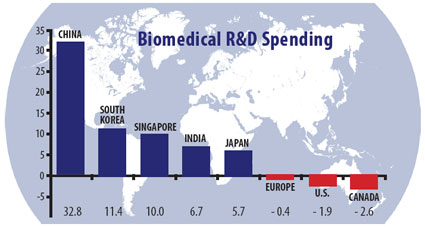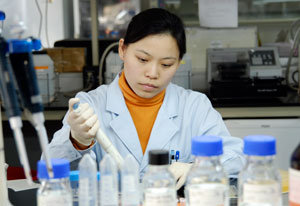America is losing biomedical research leadership to Asia
January / February 2014 | Volume 13, Issue 1
By Cathy Kristiansen
The U.S., which has long led the world in biomedical research and development (R&D) spending, is slowly reducing its investments while other countries - particularly in Asia - are boosting theirs, according to an analysis by experts from health care agencies, universities and research groups.

Compound annual growth rate of biomedical R&D expenditures by
country, inflation adjusted, in percentages, 2007-2012. See chart
description below. (NEJM)
Their report, "Asia's Ascent - Global Trends in Biomedical R&D Expenditures," was published recently in the New England Journal of Medicine. In the 2007-2012 period studied, the U.S. share of global public and private biomedical R&D investments slumped from 51 to 45 percent, a change the authors term "remarkable," especially given that the U.S. not so long ago funded as much as 80 percent of the global activity.
Meanwhile, many Asian countries raised their investments in the same period with double-digit annual growth rates, topped by China's hefty 33 percent. Japan's total spending expanded by the biggest absolute dollar amount of any country: $9 billion.
In the year since the study's cutoff date, the situation has continued to deteriorate for the U.S. as government budget cuts curbed biomedical research funds further. "We are at a crisis point," said NIH Director Dr. Francis S. Collins in a recent C-SPAN TV broadcast. "In terms of our ability to do research, NIH has received a 25 percent cut, all told, in the past 10 years."
Collins has underscored to Congress the importance of NIH-funded research to overall U.S. economic activity. It advances scientific products and technologies, creates economic growth, supports high-paying jobs and enhances health and quality of life.
"Across the board we need to turn this around," Collins said, according to a report in The Atlantic. "You look at what a country invests in research and development as part of GDP, as an indicator of the health of the [nation's seriousness]. Right now we are at 2.6 percent. Many other countries are at 3 percent or above - they're basically out to eat our lunch."
Most alarming, Collins warned, is the prospect that some lost ground cannot be recovered. NIH now funds only about 15 percent of grant applications, whereas it traditionally funded about a third, leaving burgeoning numbers of scientists discouraged and more likely to change careers or take their skills overseas. "Research isn't like a spigot that you turn on and off at will," he said in his C-SPAN comments. "If we lose scientists, they're not coming back when things get better."

Photo courtesy of NovoNordisk R&D Center China
The U.S. is losing its leadership in biomedical R&D
spending and its ability to compete globally, as it
cuts its investments and Asian countries expand
theirs.
Damage is also being done to mid-career scientists whose funding is not being renewed, he noted, which means NIH is losing the impact of its previous research investments as well.
Although the NEJM report showed the U.S. combined private and public biomedical R&D spending in 2012 still dwarfed that of any other individual country, the speed of change is dramatic. Asia-Oceania's total R&D spending surged by a half between 2007 and 2012.
Contributing to Asia's blossoming biomedical sector are its cheaper labor costs and higher government subsidies, the NEJM authors wrote, pointing out that U.S. development costs per drug approval have meanwhile "increased considerably." They called the lack of U.S. national strategy for biomedical R&D "disappointing," and said if the U.S. hopes to uphold its leadership in the field, it must boost not only NIH funding, but also provide incentives to industry to encourage more R&D investment at home.
More Information
Description of chart of biomedical R&D spending: Bar graph showing compound annual growth rate of biomedical R&D expenditures by country or region in percentages: China up 32.8, South Korea up 11.4, Singapore up 10.0, Australia up 6.9, India up 6.7, Japan up 5.7, Taiwan up 5.2, Europe down 0.4, United States down 1.9, Canada down 2.6.
To view Adobe PDF files,
download current, free accessible plug-ins from Adobe's website.